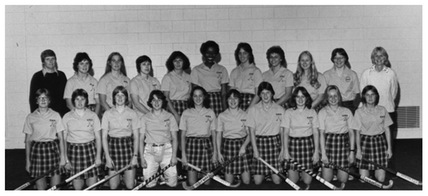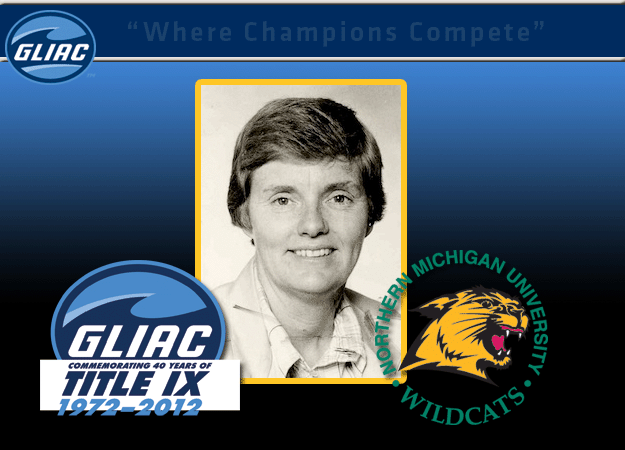Release courtesy of Cindy Paavola, Director of Communications and Marketing at Northern Michigan University
MARQUETTE, Mich. – Former Northern Michigan University associate athletic director Barb Patrick has no legal background, but she feels she’s an expert in one particular federal law, the one known as Title IX.
Title IX is part of the Education Amendments of 1972, which were signed into law 40 years ago on June 23, 1972, and mandates that no person can be discriminated against on the basis of gender regarding participation or benefits of any program or activity offered by an educational institution that receives federal financial assistance. While the law covers any type of program or activity at an educational institution, Title IX has become most widely known for the dramatic changes it brought about in youth and college sports.
To Patrick, Title IX is not a complicated law. It has always been simply about being fair.
Patrick, who came to NMU in 1965 as a physical education instructor, has literally watched the NMU women’s athletic program grow from day one to present, and she’s proud to say that Northern has an “outstanding athletics program today.” But she, maybe more so than any other person, has not forgotten the bumpy road taken to get to the present state.
Patrick was the women’s athletic coordinator from 1974-76, assistant athletic director from 1977-82 and the associate athletic director from 1983 until her retirement in 1989. She would serve as national vice president and Michigan commissioner for the Association for Intercollegiate Athletics for Women (AIAW), the national governing body for collegiate women’s athletics until 1982. She was also the first woman inducted in the NMU Sports Hall of Fame in 1984. However, Barb considers Rico Zenti, department head in the 1960s of what is now the Health, Physical Education and Recreation department, the “godfather of NMU women’s athletics.”
“I remember going into his office and asking him if I could start a women’s field hockey team. He gave me $300 for the year to start the team. I always appreciated his support of women’s athletics,” she recalls.
 The field hockey team became NMU’s first official
intercollegiate varsity program. Today, there are eight Wildcat
women’s and five men’s teams (see related chart). The
2012-13 intercollegiate program consists of 194 female and 157 male
roster spots, or a 55-45 percent split. Today’s NMU’s
general student population is 54% female and 46% male.
The field hockey team became NMU’s first official
intercollegiate varsity program. Today, there are eight Wildcat
women’s and five men’s teams (see related chart). The
2012-13 intercollegiate program consists of 194 female and 157 male
roster spots, or a 55-45 percent split. Today’s NMU’s
general student population is 54% female and 46% male.
The discussion of equal opportunity was taking place on the NMU campus prior to the final passing of Title IX.
In 1971, NMU president John X. Jamrich convened an equal opportunity task force. In 1975, three years after Title IX became law, the U.S. Department of Health, Education and Welfare issued formal regulations implementing the legislation. That year, Jamrich appointed Peggy Frazier, pharmacist of the NMU Health Center, as the university’s Title IX consultant. She chaired a campus-wide institutional self-evaluation of Title IX compliance.
Patrick was a member of that project’s athletics review subcommittee. Among its recommendations were: adding three sports – gymnastics, swimming and diving, and tennis – over three years; moving the funding of men’s and women’s sports to a more equitable model; giving women coaches release time from their regular teaching duties equal to what the men’s coaches were given; and addressing facility issues, such as inadequate women’s locker rooms and equitable access to facilities for practice and competition. Patrick would continue to battle many of these issues throughout her career.
“For instance, all of the women’s teams had to share one very small locker room. As a team came into season it would move in and the team ending its season would move out,” remembers Patrick. “This was not the case for most of the men’s teams.
“One of the most frustrating issues was the equal release time. It took until 1987 to fix that—16 years after the passage of Title IX—before men and women coaches were treated equally in terms of teaching vs. coaching assignments.”
Patrick says that creating positive change for the Wildcat women’s athletic program was all about “quiet persistence and excellent documentation.”
She keeps a copy of a 1970 Mining Journal news article with the headline Kittens Divide Field Hockey Doubleheader. “I had to explain why allowing someone to call our women athletes ‘kittens’ was not acceptable. I pointed out that a wildcat can be either gender, and that if the women were going to be called kittens, the men’s teams would need to be called tomcats. We never had another kitten headline.”
According to Patrick, the advent of technology would play an important role in helping administrators and the public realize inequities in funding. “When the university was moving from having departmental budgets on paper to having them in electronic spreadsheets, I helped Brian Verigin ’82 BS, ’87 MBA, who was the athletic department’s business manager at the time, with that conversion. From there we were able to make some pie charts using the data. I’ve always said a picture is worth a thousand words and some of those pie charts where very telling.”
“It was easier to see the percent of men’s and
women’s participation versus the percent of each line item in
the budget for such things as scholarships, recruiting, equipment and supplies,
travel and etc., compared to what percent the men had,” Barb
says.
such things as scholarships, recruiting, equipment and supplies,
travel and etc., compared to what percent the men had,” Barb
says.
Although women’s collegiate sports have come a long way, there is one thing Barb still hopes to see in her lifetime and that is an abundance of qualified women coaches competing for the top coaching positions of women’s and men’s teams.
“We’ve had nearly two generations now of women who have grown up playing competitive sports, and have had access to entry-level coaching experiences as assistants and graduate assistants—that’s critical to growing the pool of qualified women coaching candidates,” Patrick says. “Early on, women were hired to coach women’s teams because the salaries were low, so qualified men didn’t want the jobs. But as the salaries became more equitable, women’s sports programs became attractive coaching jobs for men and women, and often times the men simply had more experience or a higher level of qualification.
Today, more women can compete with men in both experience and level of past competition when it comes to qualifying for jobs.”
But Barb adamantly opposes the idea that women coaching candidates should be given the inside track to coaching positions for women’s programs.
“Whoever the coach is, she or he needs to be the best qualified candidate,” she says. “Giving your female athletes the best coach possible, whether the person is a woman or a man, is the right thing to do.”
After all, in Barb’s eyes, Title IX has always been about being fair.








































































































































































































































































































